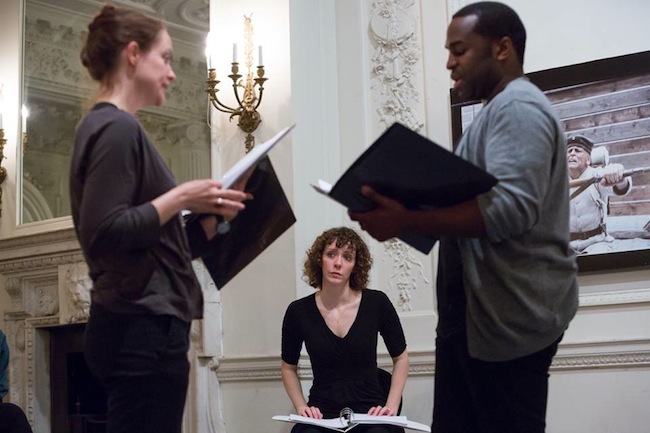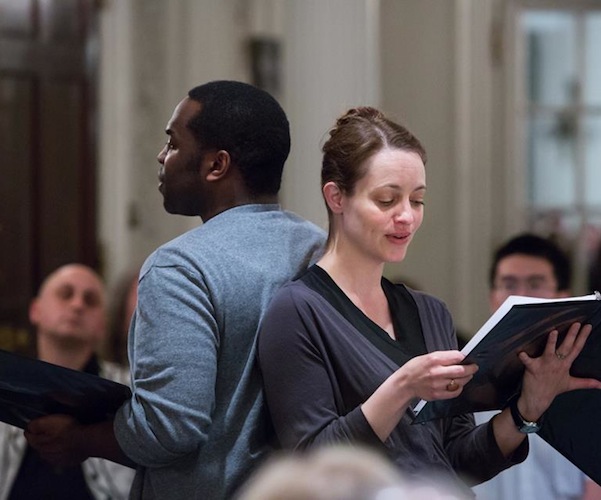Theater Review: An Enigmatic “Abyss” — A Crime Drama About Serbs in Germany
Does the distrust of (even a little) narrative ambiguity by North American dramaturgs and audiences mean that international plays must be made more ‘cinematic’ when they are produced here?
Abyss by Maria Milisavljevic. Translated by the author. Staged reading directed by Guy Ben-Aharon. Presented by German Stage at the Goethe-Institut Boston. May 8, 2014.
By Ian Thal
Theater is the one form of literature whose objectivity is taken for granted. The playwright might have biases, characters might deceive, stagecraft might cast illusions, but what happens on the stage is seen and heard by the audience in real time, as it happens.
German-born playwright Maria Milisavljevic’s cryptic Abyss, which earned her the prestigious Kleist Promotional Award for Young Dramatists in 2013, plays with our assumptions about theater’s objectivity. The script, which was presented in a staged reading at the Goethe-Institut in Boston earlier this month, is mediated by an unnamed narrator (Stacy Fischer), who is listed only as “I” in the script and program notes. At first, she describes a custom from her childhood in Serbia, at a point in time when Serbs still thought of themselves as Yugoslavian. She and her sister, Sophia, had pet rabbits, which their grandfather would later kill for meals once they had been fattened up. The girls would get the soft tails as mementos. The notion may seem grotesque to a contemporary audience, but American boys commonly carried rabbits’ feet as amulets as recently as the 1970s.
The killing of the rabbits becomes one of many recurring motifs in Abyss. At various points in the play, the audience is walked through the process of caring for, killing, and cooking the doomed animals. These narratives are chiefly delivered in the third person by “She” (Marianna Bassham, whose primary role is that of Sophia) and occasionally by “He” (Omar Robinson, in this context possibly the voice of the girls’ grandfather). These descriptions take a number of different forms: aphoristic (“Animals must learn to trust. Men were born to trust, Men must learn to lose.”), clinical, and culinary. The sequences begin as the girls nurture the small creatures, earning the trust and love that makes dispatching them all the easer, and then runs through their attempts to remember how their grandfather slaughtered the animals, skinned, and gutted the carcasses and then cooked them over an open fire, using the heads for soup. There are even morbid comic moments when the slaughter does not go as planned.
The dispatching of the animals epitomize Abyss‘s plot, which explores the intermingling of love, knowledge, truth, and violence. The narrator (I) lives in a unnamed German city with Vlado (Robinson), a fellow Serbian immigrant. One night, while making pizza at home, Karla, who is both Sophia’s roommate and Vlado’s lover, disappears to the corner market to buy cheese. She never returns. As the days pass, the police prove to be unhelpful while the trio are reluctant to go to the press for fear that the local newspaper will sensationalize the story. With help from the narrator’s love interest, Jan (also played by Robinson), the friends set out to solve the mystery themselves, using a combination of old-fashioned legwork and 21st century social media.
In a conventional play, this would be a setup for a crime-thriller. The hunt for clues take the protagonists from their living room to the city’s Russian quarter, then to the metropolis’ iced-over river and Vlado’s grandparents’ home in Croatia. But the procedural is undercut by the unreliability of the narrator, who often diverts the audience’s attention by providing extraneous information. She describes at length the eyes, hair, and footwear of the dramatis personae; she also shares intimate details about her friendships with both Vlado and Karla (not surprisingly, she is more distant with her adult sister) even as she refuses to explain the significance of these details.
Increasingly, it becomes apparent that the narrator not all that concerned about finding Karla. The girl’s disappearance serves as an opportunity to wax nostalgically about the past: to describe the time, while swimming off the Croatian coastline, Karla first entered their lives and to recall Karla’s cute ritual of drawing hearts on all of her footwear. So why is “I” telling us all of this? The narrator’s chattiness seems to be symptomatic of her egotism: she enjoys letting the audience in on how much she loves the missing Karla, how much she enjoys Jan, her new love, and how close she is with Vlado. By withholding her motives, “I” passively prolongs the rivalry between her old friend Vlado and her new love Jan, which makes her an object to be loved, a center of attention.
This passivity extends to the investigation. The narrator tags along, characterizing Vlado as a dogged protagonist one finds in crime films, using such admiring epithets as “Vlado is one of the kind that finds,” especially once they enter the economically depressed quarter for Russian immigrants known as “The Russian Barracks.” Vlado also sees himself as a hero, reciting the Otto Ernst’s ballad, Nis Randers (a poem that many Germans memorize in school). Nis’ rescue of his brother Uwe (“Huey” in the translation) from a shipwreck becomes an allegory for his own quest to find Karla. Sophia, meanwhile, grows increasingly frustrated both with Vlado’s recklessly intuitive manner of investigation, and the narrator’s minimal interest in finding Karla.
Along the way, we learn that Vlado’s quest is also an attempt to redeem his victimization during the 1991-95 Croatian War of Independence (or War in Croatia, as Serbian sources generally label it). He witnessed a home invasion by local men that left his mother dead and him traumatized. The exact nature of the attack is kept hidden from the audience, but rape was a common weapon in the Yugoslav Wars. We know neither the identity nor the motives of the perpetrators: though Vlado is a Serb, his mother is a Croat (ethnic identity amongst southern Slavs is patrilineal). Were the men Serbs attacking a Croat woman, or where they Croats punishing one of their own for marrying a Serb? While Vlado and the narrator know (or think they know), they do not tell us. Either way, Goran, Vlado’s father, took his son from the fractured Yugoslavia to the reunified Germany.
The secrecy that surrounds the personal stories from the Yugoslavian wars is not unusual. When I visited Kosovo in 2012, my Albanian hosts often told me of their near death experiences at the hands of Serbian soldiers — and then asked me never to repeat their stories to anyone.
German Stage director Guy Ben-Aharon deviated from his standard practice of using temporary risers at the front of the Goethe-Institut’s function room for the reading. Instead, he placed his actors at the center of the room with seats on either side, creating the intimacy that Fischer’s narrator needs to lure the audience into her world. Ben-Aharon deftly maneuvered Fischer, Bassham, and Robinson around the playing space. Bassham’s Sophia nimbly alerted us to doubt the narrator. Robinson changed his body language and vocal intonations expertly as he plays the two rivals, Vlado and Jan.
The play offers a number of fascinations, visceral and intellectual: the whodunit, along with the slow revelation of its characters’ broken lives, reflects the confusion of a Europe that has yet to recover from either the Cold War or the Yugoslav Wars.

Marianna Bassham (center) and Omar Robinson and Stacy Fischer in the German Stage reading of “Abyss.” Photo: Alena Kuzub
Milisavljevic is currently International Playwright-in-Residence at the Tarragon Theatre in Toronto, and mentioned during the talk-back at the Goethe-Institut that the version of the play presented here was close to the version performed in Germany. But that the text being prepared for the Tarragon had been revised: it was more linear, less disruptive of the dramaturgical rules that the theater’s audiences expect. In Milisavljevic’s view, German theatergoers enjoy being puzzled by what happens on stage but, based on her experience in Toronto, North American audiences (or at least the literary departments at major theaters) demand that a story have more clearly defined relationships between the characters.
Intrigued, I contacted Milisavljevic, so that I might compare the two scripts. She complied. The plot remained the same, but the way it is told is different. The Boston script is gnomic (in terms of being enigmatic and its use of aphorisms). The Toronto script is slightly more prosaic: the characters’ tics are explained, the narrator’s narcissism is explicitly commented on. The only factual change is that of Karla’s surname, which transforms her from being a Polish-German to someone with a less ambiguous German identity. The Toronto script still contains the interludes from Nis Randers and the instructions on how to slaughter and cook a rabbit, but the story is presented in a more straightforward fashion. Indeed, Milisavljevic opined during the talk-back that the Toronto revision could easily be adapted into a screenplay for a crime film. The Boston version centers on the narrator’s relationships and with the ambiguity of our notion of the truth. There are virtues in both approaches, but in the end, this critic prefers the greater dramatic and intellectual excitement generated by the strangeness of the Boston script over the emphasis on Vlado’s amateur sleuthing in the Toronto revision.
Milisavljevic was intrigued by reworking her story to fit the aesthetics of different countries. North American stage practice often includes the playwright in the production process. (German theater is known for being a director’s theater, where the playwright is often excluded from the final product as a matter of principle.) For a critic, the revisions of Abyss pose important questions about the staging of foreign plays in America. Does the distrust of (even a little) narrative ambiguity by North American dramaturgs and audiences mean that international plays must be made more ‘cinematic’ when they are produced here? Will this become a new trend in presenting international theater? Plays will not only be translated into another language, but will be shaped according to the presenting organization’s aesthetic, even rewritten to fit the latter’s conception of what new scripts ought be. Some have argued that this is already becoming a norm for North American theaters and their developmental dramaturgs in dealing with homegrown playwrights; they want the playwright to “authorize” the desired changes. The question is, how significantly different is this than the practice in German theater, where directors have the license to cut or rearrange scenes, or even insert additional material? In the end, is it that the German audience understands that they are seeing the director’s interpretation of the play, while the North American audience believes that they are seeing what the author intended?
Indeed, what shall we make of the title? In German it is Brandung — which is usually translated as “surf” or “breakers.” It refers to the powerful currents which threaten to drown both Nis and Uwe Randers as well as the waters into which Vlado and the narrator dive. In contrast, “abyss” is often understood in German as “Abgrund,” which, in the context of the play, may signify the chasms beneath the waves or the rifts between people.
Ian Thal is a performer and theatre educator specializing in mime, commedia dell’arte, and puppetry, and has been known to act on Boston area stages from time to time, sometimes with Teatro delle Maschere, and on occasion served on productions as a puppetry choreographer or dramaturg. He has performed his one-man show, Arlecchino Am Ravenous, in numerous venues in Massachusetts and Rhode Island, and is currently working on his second full length play; his first, though as-of-yet unproduced, was picketed by a Hamas supporter during a staged reading. Formally the community editor at The Jewish Advocate, he blogs irregularly at the unimaginatively entitled From The Journals of Ian Thal, and writes the “Nothing But Trouble” column for The Clyde Fitch Report.

